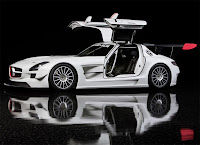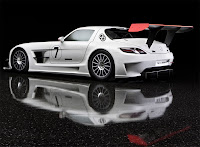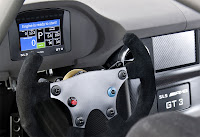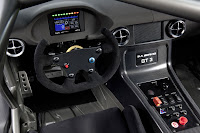The new 2011 Kia Optima / Magentis was unveiled at the New York Auto Show.
The 2011 Kia Optima will offer customers a choice of three powertrains: a 200-horsepower 2.4-liter gasoline direct-injection four-cylinder engine, a 274-hp turbocharged 2.0-liter GDI four-cylinder and, in calendar-year 2011, a 2.4-liter gasoline-electric hybrid system. The base LX model features a six-speed manual gearbox, while a six-speed Sportmatic automatic with paddle shifters is available on all models.
The Optima comes in three trims, LX, EX and SX. The LX starts with chrome-tipped exhaust, solar glass and 16-inch wheels. The EX adds fog lamps, heated mirrors, chrome or body-colored door handles and 17-inch wheels. The SX further loads on upgraded lights with HID technology front and LED rear, unique front grille design, rear lip spoiler, red brake calipers and 18-inch wheels.
Kia offers upgrades for the EX and SX trims such as power panoramic sunroof, leather seat trim, memory driver’s seat, heated and cooled front seats, heated rear seats and a heated steering wheel for additional interior refinement.














Press Release
- Midsize Sedan Offers a New Level of Style and Performance Features from
Kia - Three all-new powertrains, including turbo and Kia's first-ever hybrid
offer class- leading power and fuel economy - Segment-leading premium amenities and technology features
NEW YORK, April 1, 2010 – Kia Motors America (KMA) today globally unveiled
the all-new 2011 Optima midsize sedan at the New York International Auto
Show. Arriving in showrooms in early fall, the next generation Optima
continues Kia's design-led transformation while revealing a completely new
and stunning design language for Kia, highlighted by a dynamic and
streamlined profile that conveys elegance and athletic confidence from every
angle. Optima's groundbreaking spirit continues under the hood and inside
the cabin with the introduction of three new powertrains – including the
brand's first-ever hybrid in the U.S. (available in 2011) – which deliver
class-leading power1 and fuel economy while the latest technology features
and luxury amenities are available at the touch of a button or a simple
voice command.
Designed at Kia's studios in Frankfurt and Irvine, Calif., the all-new
Optima is longer, wider and lower than the vehicle it replaces and is based
on an all-new midsize platform that allowed for distinctive dimensions and
proportions in the segment1 while also providing a unique canvas for Kia's
global design team to pen a vehicle that stands apart from everything else
in the segment.
"The all-new Optima is a new strand in Kia's growing design DNA with a blend
of simple and fluid lines and elegant but uncomplicated shapes that draw the
attention of the eye in much the same fashion as a perfectly-tailored fine
Italian suit," said Peter Schreyer, chief design officer, Kia Motors
Corporation. "From the distinctive sweeping chrome accent that stretches
through the C pillars to the sleek greenhouse and flared wheel arches, every
inch of the Optima projects a distinguished and refined style and extreme
attention to detail."
The all-new Optima also employs engine management systems like direct
injection and turbocharging to help bring performance to the brand without
sacrificing fuel efficiency. Its smooth-flowing lines speak of grace and
style and offer a strong hint of European luxury.
Sleek and Streamlined Exterior
The 2011 Optima projects a high-performance yet elegant image with its
unique silhouette and sleek stance that builds upon Kia Motors' philosophy
of creating high quality and dynamic vehicles that evoke passion. The
striking face of Optima features Kia's signature bold tabbed grille that is
surrounded by projector headlamps. Longer, wider and lower than before,
Optima's coupe-like profile is enhanced by a sweeping chrome arc that flows
from the A through C pillars, a distinctive design motif that visually
lowers the car further and enhances its proportions. Optima's roofline
connects with its high and pronounced shoulder line that leads to its
sculpted flanks and extended wheelbase. Boldly flared wheel arches and a
raked cabin create a sedan with a graceful muscular stance.
Available in three trims, LX, EX and SX, the 2011 Optima offers numerous
standard features. The LX includes dual exhaust with chrome tips, solar
glass, outside mirror turn signal indicators and 16-inch steel wheels fitted
with 205/65R16 tires. Upgrading to the EX offers standard fog lights, heated
outside mirrors, exterior chrome/body-color door handles along with 17-inch
alloy wheels with P215/55/R17 tires. Moving up to the athletic SX adds HID
headlights with auto leveling, LED rear combination lights, unique front
grille design, rear lip spoiler, sculpted side sills, aero wiper blades, red
brake calipers and 18-inch black machined finish alloy wheels furnished with
P225/45R18 tires, achieving a true performance look.
Luxuriously Equipped Interior
From the moment the door opens, Optima presents an immediate sense of a
driver's car. The instrument panel is contoured toward the driver to suggest
a cockpit feel with precise gauges and controls for an overall sport
performance experience without sacrificing comfort or roominess. Paddle
shifters behind the steering wheel convey that Optima is built for people
who are passionate about cars. A high console with a short shifter adds to
the cockpit perception while an available panoramic sunroof provides an
open-air feeling. Offering occupants both space and comfort with a number of
standard convenience features, the sedan's chic cabin unifies with the
exterior design by welcoming its passengers with lean and ergonomic seat
design and effective storage throughout. Modern standard features such as
six-way adjustable driver's seat with power lumbar support, illuminated
vanity mirrors and a trip computer further expand the cabin's luxurious
qualities.
In addition to offering a comfortable cabin, impressive technology features
also come standard throughout, including an AM/FM/CD/MP3/Sat audio system
with SIRIUS® Satellite Radio capabilities with three months complimentary
service. Also standard on all trims are auxiliary and USB audio input jacks
for connecting with MP3 players and Bluetooth® wireless technology
connectivity with steering wheel-mounted voice activation controls to enable
hands-free operation for compatible mobile phones.
Additional standard interior features include a tilt/telescopic steering
column, power door locks, power windows, sun visor extension and an
air-conditioned glove box. Stylishly appointed cloth seats provide
comfortable seating while a 60/40 split-folding rear seat offers multiple
seating and cargo arrangements depending on driver and passenger needs.
Optima LX with automatic transmission features cruise control and an active
EcoMinder® indicator for optimal fuel efficient driving.
Optima EX comes well-equipped and offers premium standard features,
including the UVO powered by Microsoft® infotainment system with rear-view
camera, push button-start ignition with smart key, dual-zone automatic air
conditioning with rear vents, a leather-wrapped steering wheel and shift
knob, auto-dimming rear view mirror with Homelink® and compass, auto light
control, driver and front passenger automatic window up/down and eight-way
power driver's seat, lighted glovebox, rear reading lamps, floor mats and
chrome door handles.
For consumers looking for even more sporty appeal, the Optima SX adds unique
black leather woven seat trim, black interior trim with carbon insert film
and metal accent, Supervision™ meter cluster with LCD display, center fascia
and meter housing, soft trim with French seams, steering wheel paddle
shifters, metal pedals and lighted metal door scuff plates.
Available upgrades for the Optima EX and SX trims include a power panoramic
sunroof, leather seat trim, memory driver's seat, heated and cooled front
seats, heated rear seats and a heated steering wheel for additional interior
refinement. Luxuriously appointed features, including an Infinity® 5.1
surround sound audio system with HD Radio®, and eight speakers delivering in
excess of 500-watts of system power and voice-activated navigation system
with a seven-inch screen enhance the cabin for audiophiles or those who seek
the latest superior quality technology for a modern driving experience.
All-New Advanced Platform
The 2011 Optima is distinctive, right down to its all-new platform. Optima's
low, lean and powerful stance is assisted through its overall length of
190.7 inches, an increase of 1.7 inches over the previous model. Optima is
built on a platform with an overall width of 72 inches and wheelbase of 110
inches, an increase of 2.9 inches, and has a low ground clearance of 5.3
inches for enhanced aerodynamics. Optima's lightweight design uses
high-tensile-strength steel to enhance structural strength while also
achieving high torsional stiffness, benefiting handling, ride quality and
refinement. Additional measures to help ensure good noise vibration and
harshness (NVH) reduction qualities are fitted throughout the Optima.
Built on a unibody frame, the front-wheel-drive Optima utilizes independent
front and rear suspension systems. MacPherson struts are used in the front
with a multi-link layout in the rear and are both joined with coil springs
and front anti-roll bars to engage drivers with responsive handling and
provide the utmost comfort whether the road is smooth or less than ideal.
Class-Leading Efficient and Powerful Engines
The 2011 Optima is available in three all-new and fuel-efficient Theta II
powerplants, a 2.4-liter GDI four-cylinder, a 2.0-liter GDI turbo engine or
a 2.4-liter hybrid. The 2.4-liter GDI engine produces 200 horsepower and
upgrading to the available 2.0-liter turbo GDI engine (SX model) delivers
V6-type power with a four-cylinder engine that produces 274 horsepower1,
while mated to a six-speed automatic transmission. This represents Kia's
first application of GDI technology, while a 2.4-liter hybrid Optima will be
introduced in 2011. All automatics feature Sportmatic™ clutchless shifting.
A single six-speed manual transmission is available only with the LX
four-cylinder model.
Safety-Minded
The 2011 Optima is equipped with a high level of standard safety features,
as is the rest of the Kia line-up. This includes six airbags (dual advanced
front and front-seat mounted side as well as full-length side curtain),
front active headrests, side-impact door beams, height-adjustable front
seatbelts with pre-tensioners and force limiters, three-point seatbelts for
all seating positions, Lower Anchors and Tethers for Children (LATCH) and a
Tire Pressure Monitoring System (TPMS). Four-wheel antilock brakes (ABS),
Electronic Stability Control (ESC), a Traction Control System (TCS), a Brake
Assist System (BAS) and Hill Assist Control (HAC) also are standard.
Competitive Warranty
The 2011 Optima is covered by Kia's warranty program, which offers
unprecedented consumer protection. Included in this program are a
10-year/100,000-mile limited powertrain warranty, a five-year/60,000-mile
limited basic warranty and a five-year/100,000-mile anti-perforation
warranty. A five-year/60,000-mile roadside assistance plan also is part of
the vehicle coverage.
Kia Motors America in 2010
Kia Motors is in the midst of a dramatic, design-led transformation, which
has been delivering dynamically styled vehicles in several important
segments at exactly the right time, contributing to the brand's continued
gains in U.S. market share. With three new vehicle introductions and several
other key initiatives planned for 2010, Kia is poised to continue its
momentum and will continue to build the brand through design innovation,
quality, value, safety features and with new technology such as the UVO
powered by Microsoft® advanced hands-free in-car communication and
entertainment system (to be available in select Kia models in the U.S.
beginning in summer 2010). The launch of the all-new 2011 Sorento CUV, the
official vehicle of the NBA and the first vehicle to be assembled at Kia's
first U.S.-based manufacturing facilities in West Point, Georgia, further
enhances the lineup, and is now in dealerships.
2011 Kia Optima Specifications
Exterior Dimensions
Overall Length: 190.7 inches
Width: 72.0 inches
Height: 57.3 inches
Wheel base: 110.0 inches
Interior Dimensions
Front Headroom: 40.0 inches
Rear Headroom: 37.6 inches
Front Legroom: 45.5 inches
Rear Legroom: 34.6 inches
Powertrain
2.4-liter GDI four-cylinder: 200 hp
2.0-liter GDI turbo four-cylinder (SX): 274 hp1
2.4-liter hybrid (early 2011 availability)
Transmission
6-speed Manual
6-speed Automatic w/ Sportmatic® shifting
Wheels & Tires
Wheels: 16-inch (LX), 17-inch (EX), 18-inch (Optional on EX, standard on SX)
Tires: 205/65R16, P215/55R17, 225/45R18
the all-new 2011 Optima midsize sedan at the New York International Auto
Show. Arriving in showrooms in early fall, the next generation Optima
continues Kia's design-led transformation while revealing a completely new
and stunning design language for Kia, highlighted by a dynamic and
streamlined profile that conveys elegance and athletic confidence from every
angle. Optima's groundbreaking spirit continues under the hood and inside
the cabin with the introduction of three new powertrains – including the
brand's first-ever hybrid in the U.S. (available in 2011) – which deliver
class-leading power1 and fuel economy while the latest technology features
and luxury amenities are available at the touch of a button or a simple
voice command.
Designed at Kia's studios in Frankfurt and Irvine, Calif., the all-new
Optima is longer, wider and lower than the vehicle it replaces and is based
on an all-new midsize platform that allowed for distinctive dimensions and
proportions in the segment1 while also providing a unique canvas for Kia's
global design team to pen a vehicle that stands apart from everything else
in the segment.
"The all-new Optima is a new strand in Kia's growing design DNA with a blend
of simple and fluid lines and elegant but uncomplicated shapes that draw the
attention of the eye in much the same fashion as a perfectly-tailored fine
Italian suit," said Peter Schreyer, chief design officer, Kia Motors
Corporation. "From the distinctive sweeping chrome accent that stretches
through the C pillars to the sleek greenhouse and flared wheel arches, every
inch of the Optima projects a distinguished and refined style and extreme
attention to detail."
The all-new Optima also employs engine management systems like direct
injection and turbocharging to help bring performance to the brand without
sacrificing fuel efficiency. Its smooth-flowing lines speak of grace and
style and offer a strong hint of European luxury.
Sleek and Streamlined Exterior
The 2011 Optima projects a high-performance yet elegant image with its
unique silhouette and sleek stance that builds upon Kia Motors' philosophy
of creating high quality and dynamic vehicles that evoke passion. The
striking face of Optima features Kia's signature bold tabbed grille that is
surrounded by projector headlamps. Longer, wider and lower than before,
Optima's coupe-like profile is enhanced by a sweeping chrome arc that flows
from the A through C pillars, a distinctive design motif that visually
lowers the car further and enhances its proportions. Optima's roofline
connects with its high and pronounced shoulder line that leads to its
sculpted flanks and extended wheelbase. Boldly flared wheel arches and a
raked cabin create a sedan with a graceful muscular stance.
Available in three trims, LX, EX and SX, the 2011 Optima offers numerous
standard features. The LX includes dual exhaust with chrome tips, solar
glass, outside mirror turn signal indicators and 16-inch steel wheels fitted
with 205/65R16 tires. Upgrading to the EX offers standard fog lights, heated
outside mirrors, exterior chrome/body-color door handles along with 17-inch
alloy wheels with P215/55/R17 tires. Moving up to the athletic SX adds HID
headlights with auto leveling, LED rear combination lights, unique front
grille design, rear lip spoiler, sculpted side sills, aero wiper blades, red
brake calipers and 18-inch black machined finish alloy wheels furnished with
P225/45R18 tires, achieving a true performance look.
Luxuriously Equipped Interior
From the moment the door opens, Optima presents an immediate sense of a
driver's car. The instrument panel is contoured toward the driver to suggest
a cockpit feel with precise gauges and controls for an overall sport
performance experience without sacrificing comfort or roominess. Paddle
shifters behind the steering wheel convey that Optima is built for people
who are passionate about cars. A high console with a short shifter adds to
the cockpit perception while an available panoramic sunroof provides an
open-air feeling. Offering occupants both space and comfort with a number of
standard convenience features, the sedan's chic cabin unifies with the
exterior design by welcoming its passengers with lean and ergonomic seat
design and effective storage throughout. Modern standard features such as
six-way adjustable driver's seat with power lumbar support, illuminated
vanity mirrors and a trip computer further expand the cabin's luxurious
qualities.
In addition to offering a comfortable cabin, impressive technology features
also come standard throughout, including an AM/FM/CD/MP3/Sat audio system
with SIRIUS® Satellite Radio capabilities with three months complimentary
service. Also standard on all trims are auxiliary and USB audio input jacks
for connecting with MP3 players and Bluetooth® wireless technology
connectivity with steering wheel-mounted voice activation controls to enable
hands-free operation for compatible mobile phones.
Additional standard interior features include a tilt/telescopic steering
column, power door locks, power windows, sun visor extension and an
air-conditioned glove box. Stylishly appointed cloth seats provide
comfortable seating while a 60/40 split-folding rear seat offers multiple
seating and cargo arrangements depending on driver and passenger needs.
Optima LX with automatic transmission features cruise control and an active
EcoMinder® indicator for optimal fuel efficient driving.
Optima EX comes well-equipped and offers premium standard features,
including the UVO powered by Microsoft® infotainment system with rear-view
camera, push button-start ignition with smart key, dual-zone automatic air
conditioning with rear vents, a leather-wrapped steering wheel and shift
knob, auto-dimming rear view mirror with Homelink® and compass, auto light
control, driver and front passenger automatic window up/down and eight-way
power driver's seat, lighted glovebox, rear reading lamps, floor mats and
chrome door handles.
For consumers looking for even more sporty appeal, the Optima SX adds unique
black leather woven seat trim, black interior trim with carbon insert film
and metal accent, Supervision™ meter cluster with LCD display, center fascia
and meter housing, soft trim with French seams, steering wheel paddle
shifters, metal pedals and lighted metal door scuff plates.
Available upgrades for the Optima EX and SX trims include a power panoramic
sunroof, leather seat trim, memory driver's seat, heated and cooled front
seats, heated rear seats and a heated steering wheel for additional interior
refinement. Luxuriously appointed features, including an Infinity® 5.1
surround sound audio system with HD Radio®, and eight speakers delivering in
excess of 500-watts of system power and voice-activated navigation system
with a seven-inch screen enhance the cabin for audiophiles or those who seek
the latest superior quality technology for a modern driving experience.
All-New Advanced Platform
The 2011 Optima is distinctive, right down to its all-new platform. Optima's
low, lean and powerful stance is assisted through its overall length of
190.7 inches, an increase of 1.7 inches over the previous model. Optima is
built on a platform with an overall width of 72 inches and wheelbase of 110
inches, an increase of 2.9 inches, and has a low ground clearance of 5.3
inches for enhanced aerodynamics. Optima's lightweight design uses
high-tensile-strength steel to enhance structural strength while also
achieving high torsional stiffness, benefiting handling, ride quality and
refinement. Additional measures to help ensure good noise vibration and
harshness (NVH) reduction qualities are fitted throughout the Optima.
Built on a unibody frame, the front-wheel-drive Optima utilizes independent
front and rear suspension systems. MacPherson struts are used in the front
with a multi-link layout in the rear and are both joined with coil springs
and front anti-roll bars to engage drivers with responsive handling and
provide the utmost comfort whether the road is smooth or less than ideal.
Class-Leading Efficient and Powerful Engines
The 2011 Optima is available in three all-new and fuel-efficient Theta II
powerplants, a 2.4-liter GDI four-cylinder, a 2.0-liter GDI turbo engine or
a 2.4-liter hybrid. The 2.4-liter GDI engine produces 200 horsepower and
upgrading to the available 2.0-liter turbo GDI engine (SX model) delivers
V6-type power with a four-cylinder engine that produces 274 horsepower1,
while mated to a six-speed automatic transmission. This represents Kia's
first application of GDI technology, while a 2.4-liter hybrid Optima will be
introduced in 2011. All automatics feature Sportmatic™ clutchless shifting.
A single six-speed manual transmission is available only with the LX
four-cylinder model.
Safety-Minded
The 2011 Optima is equipped with a high level of standard safety features,
as is the rest of the Kia line-up. This includes six airbags (dual advanced
front and front-seat mounted side as well as full-length side curtain),
front active headrests, side-impact door beams, height-adjustable front
seatbelts with pre-tensioners and force limiters, three-point seatbelts for
all seating positions, Lower Anchors and Tethers for Children (LATCH) and a
Tire Pressure Monitoring System (TPMS). Four-wheel antilock brakes (ABS),
Electronic Stability Control (ESC), a Traction Control System (TCS), a Brake
Assist System (BAS) and Hill Assist Control (HAC) also are standard.
Competitive Warranty
The 2011 Optima is covered by Kia's warranty program, which offers
unprecedented consumer protection. Included in this program are a
10-year/100,000-mile limited powertrain warranty, a five-year/60,000-mile
limited basic warranty and a five-year/100,000-mile anti-perforation
warranty. A five-year/60,000-mile roadside assistance plan also is part of
the vehicle coverage.
Kia Motors America in 2010
Kia Motors is in the midst of a dramatic, design-led transformation, which
has been delivering dynamically styled vehicles in several important
segments at exactly the right time, contributing to the brand's continued
gains in U.S. market share. With three new vehicle introductions and several
other key initiatives planned for 2010, Kia is poised to continue its
momentum and will continue to build the brand through design innovation,
quality, value, safety features and with new technology such as the UVO
powered by Microsoft® advanced hands-free in-car communication and
entertainment system (to be available in select Kia models in the U.S.
beginning in summer 2010). The launch of the all-new 2011 Sorento CUV, the
official vehicle of the NBA and the first vehicle to be assembled at Kia's
first U.S.-based manufacturing facilities in West Point, Georgia, further
enhances the lineup, and is now in dealerships.
2011 Kia Optima Specifications
Exterior Dimensions
Overall Length: 190.7 inches
Width: 72.0 inches
Height: 57.3 inches
Wheel base: 110.0 inches
Interior Dimensions
Front Headroom: 40.0 inches
Rear Headroom: 37.6 inches
Front Legroom: 45.5 inches
Rear Legroom: 34.6 inches
Powertrain
2.4-liter GDI four-cylinder: 200 hp
2.0-liter GDI turbo four-cylinder (SX): 274 hp1
2.4-liter hybrid (early 2011 availability)
Transmission
6-speed Manual
6-speed Automatic w/ Sportmatic® shifting
Wheels & Tires
Wheels: 16-inch (LX), 17-inch (EX), 18-inch (Optional on EX, standard on SX)
Tires: 205/65R16, P215/55R17, 225/45R18












